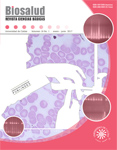Authors
Abstract
Objective: To determine the adherence of Candida albicans to polyamide and acrylic resins. Materials and Methods: In this experimental in vitro study 12 dental prostheses were made, 6 acrylic partial dentures which were elaborated under the heat-curing technique and 6 prosthesis made of polyamide by injection; 2 mm samples with irregular borders were taken from different areas of the prosthesis for analysis and variables such as temperature, heating time, polishing time, material used to shine, presence of porosities, accessory and abrasive used to remove excess were evaluated; the samples were held in distilled water for two days to remove the monomer excess and then they were incubated in a Candida albicans suspension strain ATCC 10231 and evaluated by scanning electron microscopy (SEM). Results: Porosities, cracks, blastospore and pseudohyphae were observed on the resins made from acrylic. The same results were observed on the samples made from polyamide to a lesser extent. Conclusion: Adhesion was found on the 12 samples evaluated. A statistically significant association was found between polishing type and abrasive type with a value of (p <0.05).
Keywords
References
2. Guarro J. Taxonomía y biología de los hongos causantes de infección en humanos. Enferm Infecc Microbiol Clin. 2012; 30(1):33–39.
3. , Marsh PD, Martin MV,. Microbiología oral. Quinta edición. Amolca Actualidades Médicas, C.A; 2011.
4. Singh A, Verma R, Murari A, Agrawal A. Oral candidiasis: An overview. J Oral Maxillofac Pathol. 2014 Sep; 18(Suppl 1): S81–S85.
5. Yang YL, Leaw SN, Wang AH, Chen HT, Cheng WT, Lo HJ. Characterization of yeasts colonizing in healthy individuals. Med Mycol 2011; 49:103-6.
6. Terezhalmy GT, Huber MA. Oropharyngeal candidiasis: Etiology, epidemiology, clinical manifestations, diagnosis, and treatment. Crest Oral-B at dentalcare.com Contin Educ Course. 2011:1–16.
7. Prasanna KR. Oral candidiasis – A review. Scholarly J Med. 2012; 2:6–30.
8. Rodríguez Acosta EJ, da Silva PM, Jacobina M, Lara VS, Neppelenbroek KH, Porto VC Candida albicans adherence to denture base material: chemical disinfection and the effect of acquired salivary pellicle formation. Journal of Prosthodontics 2015; 24:200-206.
9. Akalın-Evren B, Kulak-Özkan Y, Ozcan M, Kadir T. Candida albicans adhesion on reinforced polymethylmethacrylate denture resin: effect of fibre architecture and exposure to saliva. Gerodontology. 2014; 31(3):194-201.
10. Pan H, Wang G, Pan J, Ye G, Sun K, Zhang J, Wang J. Cold plasma-induced surface modification of heat-polymerized acrylic resin and prevention of early adherence of Candida albicans. Dental Materials Journal 2015; 34(4): 529–536.
11. Al-Bakri IA, Harty D, Al-Omari WM, Swain MV, Chrzanowski W, Ellakwa A. Surface characteristics and microbial adherence ability of modified polymethylmethacrylate by fluoridatedglass fillers. Aust Dent J. 2014; 59(4):482-9.
12. Sato M , Ohshima T, Maeda N, Ohkubo C. Inhibitory effect of coated mannan against the adhesion of Candida biofilms to denture base resin. Dental Materials Journal 2013; 32(3): 355–360.
13. Chandra J. Biofilm formation by the fungal pathogen Candida albicans: Development, architecture, and drug resistance. Journal of Bacteriology 2001; 183(18): 5385-5394.
14. Izumida FE, Moffa EB, Vergani CE, Machado AL, Jorge JH, Giampaolo ET. In vitro evaluation of adherence of Candida albicans, Candida glabrata, and Streptococcus mutans to anacrylic resin
modified by experimental coatings. Biofouling. 2014; 30(5):525-33.
15. Tsarev VN, Ippolitov EV, Trefilov AG, Arutiunov SD, Pivovarov AA. Features of adhesion of anaerobic periodontopathogenic bacteria and Candida albicans fungi to experimental samples of basis dental plastic depending on surface roughness and polishing method. Zh Mikrobiol Epidemiol Immunobiol.2014; (6):21-7.
16. Mayahara M, Kataoka R, Arimoto T, Tamaki Y, Yamaguchi N, Watanabe Y, Yamasaki Y, Miyazaki T. Effects of surface roughness and dimorphism on the adhesion of Candida albicans to the surface of resins: scanning electron microscope analyses of mode and number of adhesions. J Investig Clin Dent. 2014; 5(4):307-12. doi: 10.1111/jicd.12055.
17. Pan H, Wang G, Pan J, Ye G, Sun K, Zhang J, Wang J.Cold plasma-induced surface modification of heat-polymerized acrylic resin and prevention of early adherence of Candida albicans. Dent Mater J. 2015; 34(4):529-36. doi: 10.4012/dmj.2015-035.
18. Koch C, Bürgers R, Hahnel S. Candida albicans adherence and proliferation on the surface of denture base materials. Gerodontology. 2013; 30(4):309-13. doi: 10.1111/ger.12056.

 pdf (Español (España))
pdf (Español (España))
 FLIP
FLIP


















